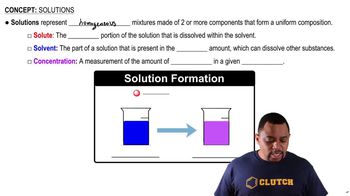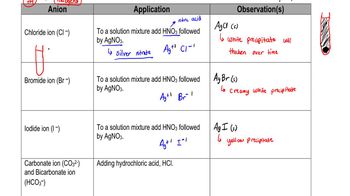Here are the essential concepts you must grasp in order to answer the question correctly.
Solubility and Ionic Compounds
Ionic compounds like NaCl, KCl, and MgCl2 are generally soluble in water, but their solubility can vary. Understanding the solubility rules helps predict how these compounds will behave in solution. For instance, while NaCl and KCl are highly soluble, MgCl2 has a different solubility profile due to the presence of magnesium, which can affect the ionic interactions in water.
Recommended video:
Conductivity of Solutions
When ionic compounds dissolve in water, they dissociate into their constituent ions, allowing the solution to conduct electricity. By measuring the conductivity of the solutions formed from each solid, one can differentiate between them. For example, MgCl2 produces more ions in solution compared to NaCl and KCl, leading to higher conductivity due to its dissociation into three ions (Mg²⁺ and 2 Cl⁻).
Recommended video:
Flame Tests
Flame tests are a qualitative analysis technique used to identify the presence of certain metal ions based on the color they emit when heated in a flame. Sodium ions produce a bright yellow flame, potassium ions yield a lilac flame, and magnesium ions do not impart a significant color. Performing a flame test on the solids can help distinguish between NaCl, KCl, and MgCl2 based on the characteristic colors observed.
Recommended video:

 Verified step by step guidance
Verified step by step guidance


